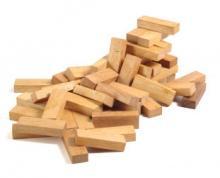
Caroline Pratt, an American innovative educator who was part of the progressive movement in the early 1900s, is credited for developing wooden blocks, called unit blocks. They were similar to the blocks used by Friedrich Froebel in his kindergartens.1 Using play with physical objects as the basis for learning revolutionized early childhood education at that time, and unit blocks continue to be used in classrooms today.2
Unit blocks are typically made of hard maple, although less expensive woods are sometimes used to lower the costs. The standard unit block measures 5 1/2” long with a width of 2 3/4” and a thickness of 1 3/8”. Other blocks in a set of unit blocks are proportioned as a multiple or fraction of the unit block. A half unit block is 2 3/4” long, the double unit block is 11” long, and the quad unit block is 22” in length. Other block shapes included in a set are columns, pillars, triangles, and curves that are also proportional to the unit block.3
While children can use unit blocks as building blocks in their play, the subtle learning of math concepts is achieved as they discover that two units are the same size as a double unit as well as four half units make a double. Using unit blocks helps children visualize the math concepts.4 The current use of manipulatives in classrooms to teach math and science had its origins in unit blocks and block play.5
When Caroline Pratt opened her school in Greenwich Village, New York, in 1914, her unit blocks were an important element to her program.6 Blocks were emphasized at City and Country School as open-ended play tools that had infinite possibilities. Children could work alone or join with others in social interaction that encouraged dramatic play and developed social skills, such as executive function, self-regulation, cooperation, problem solving, and risk taking.7
As Pratt observed children deeply absorbed in block play, she noted, “In his play (he) was thinking, learning, setting down his understanding of the way things worked, the relationship of facts to each other…educating himself.”8 Because of her extensive work in block play, unit blocks continue to be used in classrooms today as essential tools for learning.
- 1. “Caroline Pratt. wooden unit blocks.” Froebel Web. < http://www.froebelweb.org/web2027.html > 30 Nov. 2011.
- 2. Hewitt, Karen. “Blocks As a Tool for Learning: Historical and Contemporary Perspectives.” Young Children. January 2001. NAEYC. < http://www.naeyc.org/files/yc/file/Hewitt0101.pdf > 30 Nov. 2011.
- 3. “Unit Blocks.” Old Fashioned Blocks. < http://www.oldfashionedblocks.com/standard_unit_building_blocks.html > 1 Dec. 2011.
- 4. “Wooden Blocks & Wooden Toys.” Old Fashioned Blocks. < http://www.oldfashionedblocks.com/index.html > 8 Dec. 2011.
- 5. Op. cit., Hewitt.
- 6. Hendry, Petra Munro. “Learning From Caroline Pratt.” Journal of the American Association for the Advancement of Curriculum Studies. Volume 4. February 2008. < http://www2.uwstout.edu/content/jaaacs/vol4/Hendry.pdf > 30 Nov. 2011.
- 7. “A Newsletter for City & Country Families.” City and Country School. < http://cityandcountry.org/wp-content/uploads/2010/12/playfinal.pdf > 1 Dec. 2011.
- 8. Pratt, Caroline. I Learn from Children. New York: Simon & Schuster. 1948. p. 29.

